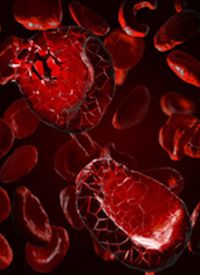Article
Orelabrutinib/Sintilimab Combo Induces Rapid Responses in Peripheral CNS Lymphoma
Author(s):
The addition of orelabrutinib to sintilimab demonstrated good efficacy with a rapid time to response in patients with relapsed/refractory primary central nervous system lymphoma.

The addition of orelabrutinib (ICP-022) to sintilimab demonstrated good efficacy with a rapid time to response (TTR) in patients with relapsed/refractory (R/R) primary central nervous system lymphoma (PCNSL), according to findings from a phase 2 study (NCT04899427) presented at the 2022 EHA Congress.1
Following 4 cycles of treatment, the overall response rate (ORR) was 61.5% with a complete response (CR) rate of 38.5% at a median follow-up of 7.0 months (range, 1.5-10.5). The median TTR was 6 weeks (range, 6-12).
R/R PCNSL is a rare, aggressive extranodal lymphoma exclusively involving the CNS at the onset. Diffuse large B-cell lymphoma (DLBCL) is the most common histological subtype. The median overall survival (OS) for these patients has recently grown to 26 months for patients younger than 70 years. For older patients, however, the median OS has stayed at 6 months since the 1970s.2,3
“The prognosis for R/R PCNSL is extremely poor, but no widely accepted standard of care or care exists,” lead author Yan Zhang, MD, an associate professor in the Department of Hematology at Peking Union Medical College Hospital, Chinese Academy of Medical Sciences & Peking Union Medical College, in Beijing, China, said in his presentation. “However, in recent years BTK inhibitors such as ibrutinib [Imbruvica] monotherapy has demonstrated significant efficiency R/R PCNSL, with overall response rates about around 50% and a median PFS [progression-free survival] around 4 to 6 months.”
Results from previous studies showed that BTK inhibitors and PD-1 monoclonal antibodies induce significant activity in patients with R/R PCSNL. Furthermore, combining those agents demonstrated synergistic effects both in vivo and in vitro in DLBCL. Zhang and colleagues sought build on these findings by evaluating the safety and efficacy of orelabrutinib, an orally administered, potent, irreversible and highly selective BTK-inhibitor; in combination with sintilimab, an investigational PD-1 inhibitor approved in China for the treatment of R/R Hodgkin lymphoma.
Investigators enrolled 13 immunocompetent adults with R/R PCNSL and eligible organ functions from March 2021 to January 2022. Patients received 150 mg of orelabrutinib once per day plus 200 mg sintilimab on day 1 of every 3-week cycle for up to 2 years or until disease progression, intolerable toxicity, or death. Patients were evaluated every 2 cycles from cycles 1-6, then every 4 cycles from cycle 7 on. The data cut-off date was February 25, 2022.
The primary objective was ORR after 4 cycles. Other end points included 1-year PFS, TTR, and safety. Cerebrospinal fluid (CSF) concentration of orelabrutinib was an experimental end point.
Ten of 13 patients completed at least 4 lines of therapy. Three ended treatment after 2 cycles due to progression.
The median patient age was 61 years (range, 48-71). Five (38%) patients had low-risk disease, 4 (31%) were intermediate risk, and 4 (31%) had high-risk disease. The median number of prior lines of treatment was 2 (range, 1-4). All patients received high-dose methotrexate, and 7 were refractory to the last treatment.
After 2 cycles of treatment, the ORR was 50% with a CR rate of 20%. Following 6 cycles, the ORR was 61.5% with a CR rate of 38.5%.
The estimated 1-year PFS rate was 67.7%. One-year OS was 92.3%. “There [were] no relapsing events in these patients,” Zhang added.
Regimens used in PCNSL are often ineffective because they cannot penetrate the blood-brain barrier. In this study, investigators collected 5 pairs of plasma and CSF samples from 4 patients to assess the ability of orelabrutinib to infiltrate the CSF.
The median CSF concentration of orelabrutinib was 28.7 ng/ml (range, 11.8-52.7). The median CSF/plasma free ratio was 59.8% (range, 46.09%-86.67%).
“It means 59.8% of orelabrutinib penetrated the brain-blood barrier,” Zhang said. “This ratio is very high, and it was similar with ibrutinib, and maybe a little higher.”
He noted that the combination was well tolerated. The most common any-grade toxicities were fatigue, neutropenia, rash and upper respiratory tract infections. Investigators observed only 1 grade 3 pneumocystis jirovecii pneumonia. There were no other grade 3/4 adverse events (AEs) or immune-related AEs.
In June 2021, the FDA granted a breakthrough therapy designation to orelabrutinib for the treatment of R/R mantle cell lymphoma.4 In results from phase 2 study (NCT04014205) of 106 Chinese patients with R/R B-cell malignancies, ORR was 82.5% and CR was 24.7%.5
References
- Zhang Y, Wang W, Zhao, et al. Preliminary results of a phase II study of orelabrutinib in combination with anti-PD-1 monoclonal antibody in refractory or relapsed primary CNS lymphoma. Presented at: 2022 EHA Congress; June 9-12, 2022; Vienna, Austria. Abstract S224.
- Mendez JS, Grommes C. Treatment of primary central nervous system lymphoma: from chemotherapy to small molecules. Am Soc Clin Oncol Educ Book. 2018;38:604-615. doi: 10.1200/EDBK_200829
- Mendez JS, Ostrom QT, Gittleman H, et al. The elderly left behind-changes in survival trends of primary central nervous system lymphoma over the past 4 decades. Neuro Oncol. 2018;20(5):687-694. doi: 10.1093/neuonc/nox187
- InnoCare announces breakthrough therapy designation of orelabrutinib by US FDA for treatment of R/R MCL. News release. InnoCare Pharma. June 28, 2021. Accessed June 27, 2021. https://prn.to/35VpN4Z
- Song Y, Song Y, Liu L, et al. Safety and efficacy of orelabrutinib monotherapy in Chinese patients with relapsed or refractory mantle cell lymphoma: A multicenter, open-label, phase II Study. Blood. 2019;134(suppl 1):755. doi: https://doi.org/10.1182/blood-2019-126305









